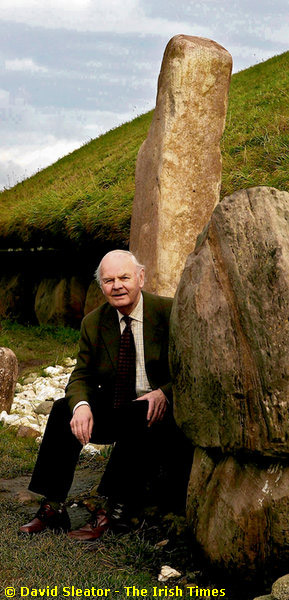George Eogan - Archaeologist, on burial rites & megalithic art.
Eoin Butler's Questions & Answers - The Irish Times - June 2012 When did you begin excavations at Knowth in Co Meath?
When did you begin excavations at Knowth in Co Meath?In 1962. I was an archaeologist with a particular interest in passage tombs. I knew it was important to carry out excavations at Brú na Bóinne and Knowth seemed, to me, to be the most interesting place I could start.
What did the site consist of at the time?
It was a large mound, about 30ft high, covering about an acre of ground. Subsequent excavations have revealed two enormous chambers with impressive kerbstones around the base and a variety of megalithic art.
Those are carvings rather than paintings, I assume?
Yes, they're non-representational carvings. Circles, triangles, symbols and so on. It's the largest collection of megalithic art anywhere in Europe. There are hundreds of stones.
How old is the site?
It dates back to 3,500 BC. That's older than the pyramids.
What function did it serve in 3,500 BC?
It was a burial chamber.
Why such an extravagant burial chamber? Was it hubris on the part of a king?
We're not certain. Certainly, society was stratified and only the remains of the upper classes would have been buried here. Unfortunately, the burial rite was cremation. The bodies were burned so, as a result, a lot of information was lost. What we can say is that the cult of the dead was a very important part of these people's lives.
Was the tomb built by slaves or by skilled craftsmen?
Skilled craftsmen, definitely. The architectural and engineering elements are so sophisticated – they had to be built by skilled people. Because of the east-west orientation of the passages, we believe there may have been an astronomical alignment with the spring and autumn equinoxes.
How has the site weathered the past five millennia? Were subsequent inhabitants of the area respectful of it? Did they build over it?
That's a very interesting question. In fact, between the 7th and 12th centuries AD, the mound at Knowth was the royal residence of the kings of Northern Brega, which occupied roughly the northern half of the modern county of Meath.
When you went down there in 1962, were you the first person to enter the tomb in 5,500 years or had previous generations pottered around in there?
The kings of Northern Brega transformed the site into a protected settlement by digging two ditches. When they were digging, they discovered the entrance to the passage. Some people went in and scratched their names on the stones.
What kind of names did people have in the seventh century?
They weren't like our names today. One name was Snedta, who was a male individual, we think.
If he was carving his name all over the place, it was definitely a man.
Yes, most likely. The other was Teistennach. They would both have been members of the Northern Brega kingdom.
You've been working at the site, on and off, for 50 years now. Is it slow, deliberate work or have there been any dramatic Tutankhamun-esque breakthroughs?
There were two such moments, in fact. Once, in 1967, we discovered a small hole on the western side of the mound. I uttered an exclamation, took my flash lamp and entered the passage. This, in turn, led to a very impressive chamber. The whole thing was over 100ft in length. It was very dramatic. The next year, we discovered a similar chamber on the eastern side. It was about 20ft high and extremely well constructed.
Prof George Eogan's Excavations at Knowth Volume 5 was launched at Knowth House, Co Meath in June 2012.
Current Archaeology article published in October 2003
The excavation at Knowth is one of the greatest pieces of archaeology of our time. On June 18th 2002 it was my privilege to be there with some students forty years to the day from the start of the excavation. After touring the site, George Eogan invited us over to a large caravan in the farmyard across the road to join the anniversary celebrations with Knowth trowellers, workmen and other local folk. This year I returned to Ireland to see George again, and to find out more about George Eogan. Why did he choose to spend the greater part of his life excavating at one site? And what was it like to be the first person in a thousand years to enter a great Neolithic passage tomb? More ...Boyne Valley Private Day Tour
 Immerse yourself in the rich heritage and culture of the Boyne Valley with our full-day private tours.
Visit Newgrange World Heritage site, explore the Hill of Slane, where Saint Patrick famously lit the Paschal fire.
Discover the Hill of Tara, the ancient seat of power for the High Kings of Ireland.
Book Now
Immerse yourself in the rich heritage and culture of the Boyne Valley with our full-day private tours.
Visit Newgrange World Heritage site, explore the Hill of Slane, where Saint Patrick famously lit the Paschal fire.
Discover the Hill of Tara, the ancient seat of power for the High Kings of Ireland.
Book Now
Home
| Visitor Centre
| Tours
| Winter Solstice
| Solstice Lottery
| Images
| Local Area
| News
| Knowth
| Dowth
| Articles
| Art
| Books
| Directions
| Accommodation
| Contact
